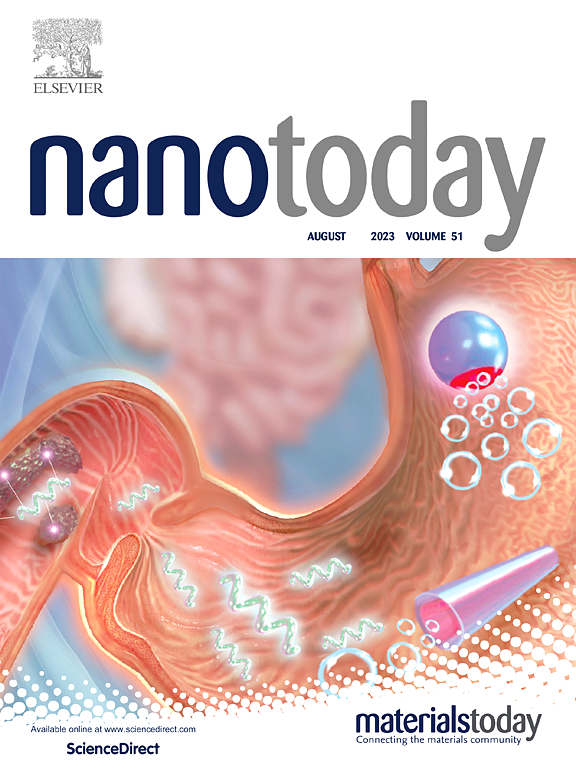Antifouling zwitterionic coating enhances electrochemical aptamer-based sensors for therapeutic drug monitoring
IF 10.9
1区 材料科学
Q1 CHEMISTRY, MULTIDISCIPLINARY
引用次数: 0
Abstract
Electrochemical aptamer-based (E-AB) sensors have experienced remarkable growth across a broad range of applications, such as precision medicine, chronic disease management, food safety, and environmental monitoring, due to their exceptional capability for real-time and continuous monitoring of biomarkers. However, biofouling in complex biological environments remains a critical challenge for the E-AB sensors, compromising signal strength, operational stability, and biosensing specificity. Here, we present a zwitterionic coating strategy that integrates poly-sulfobetaine methacrylate (SBMA) and polydopamine (PDA) to enhance the antifouling properties of the E-AB sensors, thereby enabling sensitive, stable, and accurate detection of a model antibiotic drug, vancomycin. The durable and hydrophilic antifouling layer was grafted onto the electrode surface to minimize signal drift while preserving sufficient signal on the E-AB sensors. The SBMA@PDA coating was systematically optimized and demonstrated superior resistance to biofouling under various environmental conditions, including pH, temperature, and mechanical stress. Furthermore, the coating was incorporated into a wearable microneedle patch for monitoring vancomycin dynamics in artificial interstitial fluids, achieving robust stability and performance. These findings establish a reliable and effective antifouling approach, advancing the practical application of E-AB sensors for continuous therapeutic drug monitoring in clinical and wearable healthcare settings.
防污两性离子涂层增强了用于治疗药物监测的电化学适体传感器
基于电化学适配体(E-AB)的传感器由于具有实时和连续监测生物标志物的卓越能力,在精准医疗、慢性疾病管理、食品安全和环境监测等广泛应用中取得了显着增长。然而,复杂生物环境中的生物污垢仍然是E-AB传感器面临的一个关键挑战,它会影响信号强度、运行稳定性和生物传感特异性。在这里,我们提出了一种两性离子涂层策略,该策略集成了聚甲基丙烯酸磺基甜菜碱(SBMA)和聚多巴胺(PDA),以增强E-AB传感器的防污性能,从而实现对模型抗生素万古霉素的敏感、稳定和准确检测。在电极表面接枝了耐用且亲水的防污层,以减少信号漂移,同时保持E-AB传感器上足够的信号。对SBMA@PDA涂层进行了系统优化,并在各种环境条件下(包括pH、温度和机械应力)表现出优异的抗生物污染能力。此外,该涂层被纳入可穿戴微针贴片中,用于监测人工间质液中万古霉素的动态,获得了强大的稳定性和性能。这些发现建立了一种可靠有效的防污方法,推进了E-AB传感器在临床和可穿戴医疗保健环境中持续治疗药物监测的实际应用。
本文章由计算机程序翻译,如有差异,请以英文原文为准。
求助全文
约1分钟内获得全文
求助全文
来源期刊

Nano Today
工程技术-材料科学:综合
CiteScore
21.50
自引率
3.40%
发文量
305
审稿时长
40 days
期刊介绍:
Nano Today is a journal dedicated to publishing influential and innovative work in the field of nanoscience and technology. It covers a wide range of subject areas including biomaterials, materials chemistry, materials science, chemistry, bioengineering, biochemistry, genetics and molecular biology, engineering, and nanotechnology. The journal considers articles that inform readers about the latest research, breakthroughs, and topical issues in these fields. It provides comprehensive coverage through a mixture of peer-reviewed articles, research news, and information on key developments. Nano Today is abstracted and indexed in Science Citation Index, Ei Compendex, Embase, Scopus, and INSPEC.
 求助内容:
求助内容: 应助结果提醒方式:
应助结果提醒方式:


